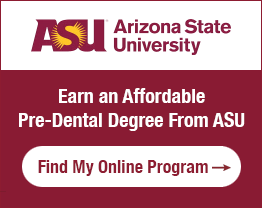The Alaska Department of Labor and Workforce Development reports strong growth and employment opportunities for dental hygienists in Alaska. In 2012, there were 571 dental hygienist jobs in Alaska. By 2022, the Department of Labor and Workforce Development projects there will be 730 licensed hygienists working in the state, representing an increase of nearly 28 percent.
Dental hygienists are licensed healthcare providers who are responsible for cleaning teeth, examining the oral cavity, taking and developing x-rays, applying fluoride or sealants, among many other duties.
Featured Programs:
- Online
If you want to become a dental hygienist in Alaska, you must achieve licensure through the Alaska Board of Dental Examiners, which requires completing the following steps:
Step 1. Complete an Academic Program in Dental Hygiene
To qualify for licensure as a dental hygienist in Alaska, you must complete an academic program in dental hygiene that has been accredited by the Commission on Dental Accreditation (CODA) of the American Dental Association and approved the Board.
The Alaska Board of Dental Examiners requires, at a minimum, the completion of an associate degree program, although individuals often choose to pursue a bachelor’s degree in dental hygiene, as it may afford them expanded career opportunities and opportunities for advancement. There are currently 2 CODA-accredited programs in Alaska.
An accredited associate degree program in dental hygiene consists of science, general education, and dental hygiene coursework that prepares students to take the National and Western Regional Examining Board (WREB) examinations required for licensure.
Dental hygiene programs include coursework in areas such as:
- Pharmacology
- Oral pathology
- Dental radiography
- Dental materials
- Head and neck anatomy
- Dental anesthesia
- Periodontics
You can expect to participate in classroom, laboratory, and clinical activities within an accredited dental hygiene program. Prerequisites for dental hygiene programs often include current CPR certification and updated immunizations.
Step 2. Pass the National Dental Examination
Once you have completed an accredited dental hygiene program, you must pass a written theory examination: The National Board Dental Hygiene Examination (NBDHE) through the American Dental Association Joint Commission on National Dental Examinations.
The NBDHE is designed to assess the ability to understand such topics as dental hygiene sciences, biomedical sciences, and dental sciences, as well as the ability to apply the information on problem-solving contexts. You can read more about the NBDHE here.
You must apply for the NBDHE through the American Dental Association’s Department of Testing Services.
Step 3. Pass the Western Regional Examining Board (WREB)
Upon the successful completion of the NBDHE, you must take and pass the Western Regional Examining Board (WREB) examination.
The WREB is administered at locations throughout the U.S. and throughout the year. A current list of examination locations, dates, and times, as well as application instructions, can be found here. Additional exam site-specific information can be found here.
Step 4. Apply for Licensure as a Dental Hygienist in Alaska
The first step to licensure as a dental hygienist in Alaska is the completion of an interview. The applicant for licensure must be interviewed in person by the Board of a designee of the Board.
Applicants must then complete the application, which consists of two, separate parts:
- Part I: Applicants must complete Part I (Alaska Dental Hygiene License by Examination) and submit it directly to the Board of Dental Examiners
- Must be completed, signed, and notarized
- Must include a credential review fee of $100 and a license review fee of $120 (made payable to the State of Alaska)
- Part II: Applicants must work directly with Professional Background Information Services (PBIS) for submission of a credentials review (Level III). The PBIS report must be sent directly to the Board by PBIS. The PBIS process usually takes about two months to complete. Applicants must contact PBIS directly at:
- Professional Background Information Services, 23460 North 19th Avenue, Suite 225, Phoenix, AZ 85027, 602-861-5867 or [email protected]
All applications are reviewed according to the date they are received. Applicants are notified in writing as soon as their application has been reviewed.
Questions regarding the application process can be directed to Stacia Erkenbrack at [email protected] or at 907-465-2542.
You may also apply for a Permit to Administer Local Anesthetic Agents with your application, if applicable.
Step 5. Apply for a Restorative Function License Endorsement
A restorative function license endorsement for dental hygienists in Alaska authorizes a licensed dental hygienist under the direct supervision of a licensed dentist to place restorations into a cavity prepared by the licensed dentist and carve and adjust contacts and the occlusion of the restoration.
You may seek a restorative function license endorsement for your dental hygienist license if you provide the Board with proof of:
- The completion of a course accredited by the Commission on Dental Accreditation (CODA) or approved by the Board; AND
- Passing the Western Regional Examining Board’s restorative examination
You must complete and sign the Dental Hygiene Restorative Function Endorsement Application and:
- Have the application notarized
- Include an application fee of $50 and an endorsement fee of $50
- Complete the Course Verification form (with the college/university seal)
- Include course description or outline from the university/college where you received your training in restorative functions
- Copy of the WREB certificate
Step 6. Maintain your Dental Hygienist License
Dental hygienist licenses are renewed biennially upon the completion of at least 20 contact hours of continuing education. All courses may be home study.
Resources for continuing education may include:







